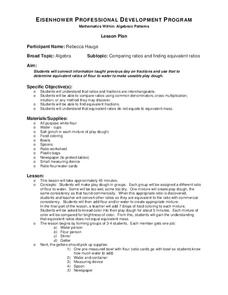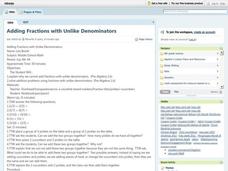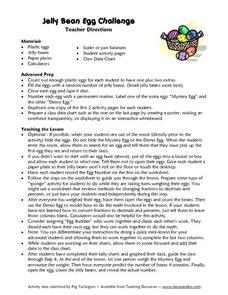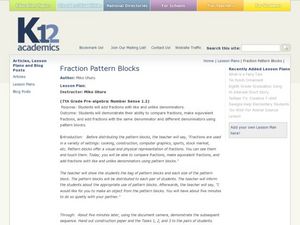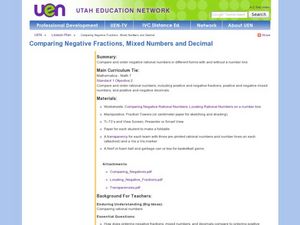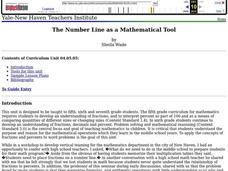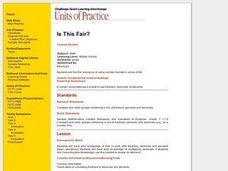Curated OER
Mathematics Within: Algebraic Patterns
Students comprehend that ratios and fractions are interchangeable. They compare ratios using common denominators, cross multiplication, and intuition. Students find equivalent fractions. They comprehend that equivalent ratios do not...
Curated OER
Comparing Apples With Apples 2
Learners use fractions strips to demonstrate addition and subtraction of fractions. They explore finding common denominations, examining equivalent fractions, and simplifying fractions. Students may work in groups or independently.
Curated OER
Adding Fractions with Unlike Denominators
Students view groups of pickles and discuss putting the groups together. Next, they discuss a group of pickles and cucumbers, can these be put together? Students listen as the teacher explains equivalent fractions and ways to change...
Curated OER
Number Sense
Students play "Fraction Line Up," a game to compare fractions with unlike denominators with the use of a deck of cards. After the game, each player explains one of the strategies that was helpful to him/her during the game. In...
Curated OER
Smaller Than One
Sixth graders practice converting a fraction into a decimal and a percent. They explain relationships among rational numbers. They order and compare whole numbers, fractions (including mixed numbers), and decimals using a variety of...
Curated OER
Veggie Chop and Data Analysis
First graders chop vegetables into fractions. In this fractions lesson plan, 1st graders cut vegetables, collect data about favorite vegetables and create a bar graph using the information. Students make inferences about the data...
Curated OER
Finding the Percent of a Number
For this mathematics worksheet, 6th graders find the percents of various numbers. They set up the problem, estimate, and write their response. Students also compare their answers to their estimates for each problem.
Curated OER
Jelly Bean Egg Challenge
Students each receive a plastic egg filled with jelly beans. In this Jelly Bean Egg Challenge, students estimate and weight their eggs, they count the number of jelly beans inside their egg, they chart their data and compare their data...
Curated OER
Fraction Pattern Blocks
Seventh graders practice using pattern blocks. In this pre-algebra lesson plan, 7th graders complete tasks that require them to compare fractions, make fractions equivalent, and add fractions.
Curated OER
Comparing Negative Fractions, Mixed Numbers and Decimal
Seventh graders explore the concept of negative rational numbers. In this negative rational numbers instructional activity, 7th graders discuss similarities between positive and negative rational numbers. Students predict what rational...
Curated OER
The Number Line
Learners graph and order numbers using a number line. They also solve word problems using fractions and decimals and rewrite equations to solve problems correctly. Several example word problems are given.
Curated OER
Is This Fair?
Students discover how to convert fractions to decimals and percents. They play the role of a shopper to complete this activity.
Curated OER
The Number Line
Eighth graders investigate the order of numbers and how they are located on the number line. They also review the symbols used to compare quantities in order to decipher simple expressions and graph them on the numberline.
Curated OER
Mathematics Within: Algebraic Patterns
Young scholars investigate the concept of using proportions to compare quantities while also practicing calculations for foreign exchange rates. They develop the skill of solving for unknown quantities of money while using an algebraic...
Curated OER
Ratios
Sixth graders investigate the concept of ratios and how they can be used to represent the comparison of quantities. The lesson is taught using a table or graph to compare two categories of data.
Curated OER
The Price Is Right - Grocery Store Prices
Eighth graders use the unit price to compare which local grocery store has the best prices. Assign students to work with a partner and a role. One person is the recorder and the other is the mathematician.
Chicago Botanic Garden
Weather or Not
What is the difference between weather and climate? This is the focus question of a lesson that takes a deeper look at how weather data helps determine climate in a region. Using weather and climate cards, students decide...
Curated OER
Penny Basketball: Making Sense of Data
Explore four web-based interactive sites to develop a baseline understanding of statistics. Learners play a series of penny basketball games and collect data regarding their shooting statistics. Groups decide who is the "top" penny...
Illustrative Mathematics
Buying Bananas, Assessment Version
Practice with unit rates, proportions, and ratios when Carlos purchases an amount of bananas. Learners must interpret a graph to decide whether points on the same line represent similar proportional relationships. Use with lesson plans...
Curated OER
Fraction Dominoes
Fourth graders participate in a math game that involves practicing their equivalent fraction skills in the advanced multiplication stage seven. They assess their ability skills of equivalent fractions to match twenty seven dominoes on...
Curated OER
Initial Fraction Ideas Lesson 5: Overview
Learners demonstrate fraction symbols. In this fractions lesson, students use paper strips to represent various fractions. Learners then use fraction circles to compare various given fractions.
Curated OER
Exploring the Slopes of Parallel and Perpendicular Lines.
Learners find the slopes for perpendicular and parallel lines. For this geometry lesson, students differentiate between parallel and perpendicular lines. They use Cabri software to create lines to compare.
Curated OER
Equivalent Fraction Paper Strips
Young learners compare the relative values of fractions by making physical representations. They fold and label strips of paper that are equal in length to represent "one whole" and the equal parts that fractions represent. Also, they...
Curated OER
Plotting Numbers and Test
Sixth graders create a human number line. They determine the correct placement of various numbers ranging from -4 to 4. Additionally, they will determine the placement of numbers written as fractions and/or decimals.
